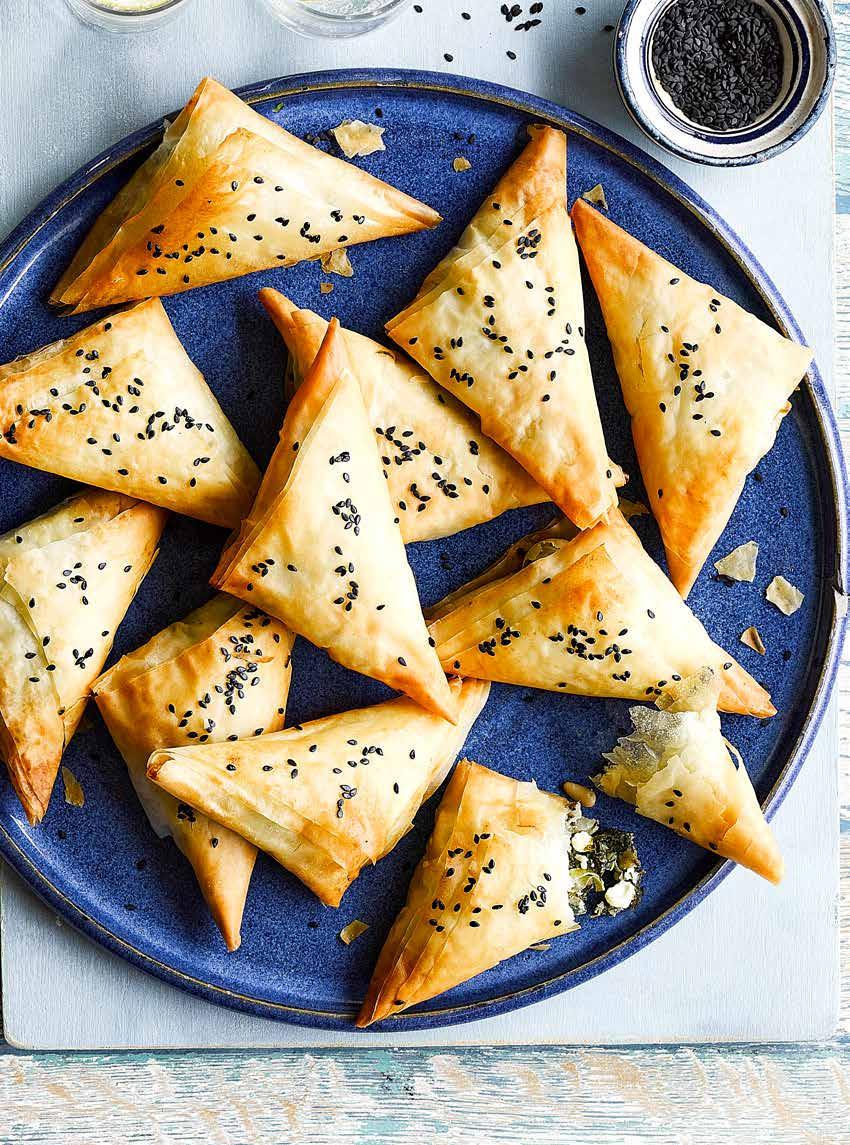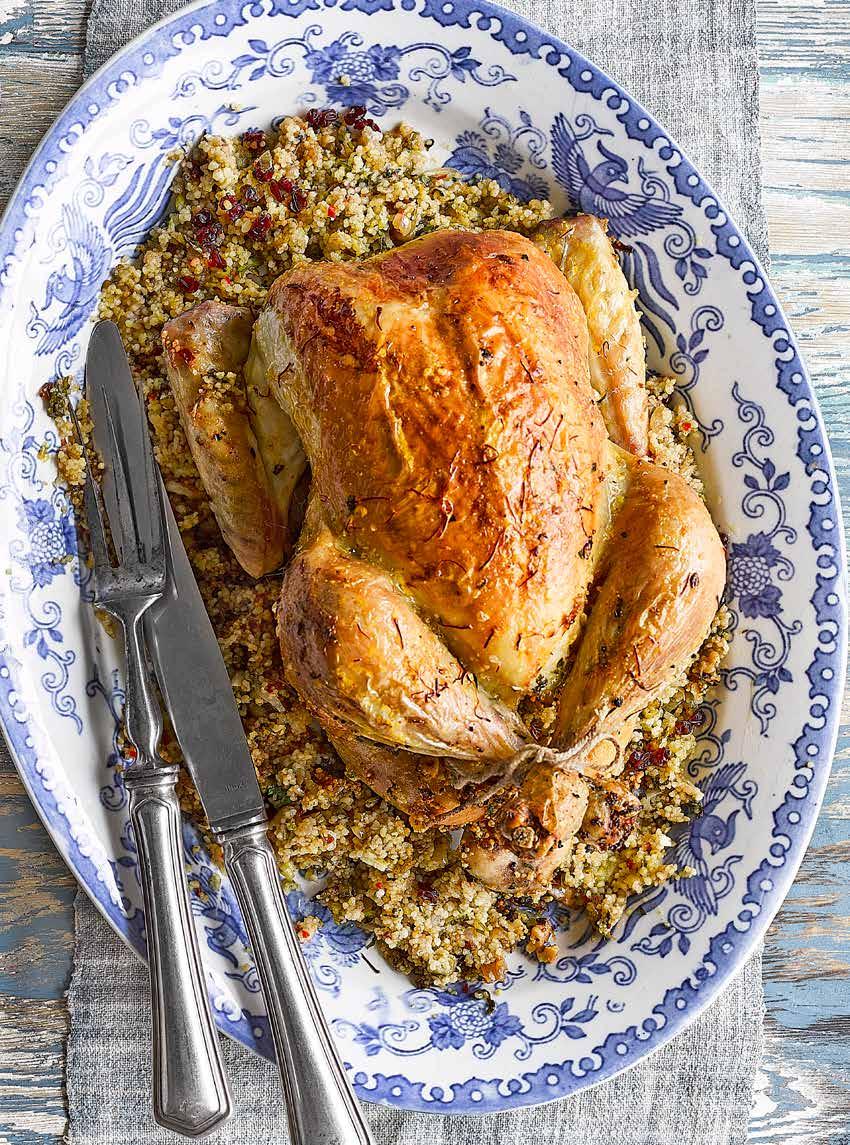
7 minute read
SWEET DATES
DIANA HENRY
Diana Henry showcases this sticky fruit in savoury recipes including a stuffed roast chicken and pan-fried mackerel
recipes DIANA HENRY photographs SAM STOWELL
It’s hard to believe that dates are fruit. They seem more of a sweet meat. Bite into one and the flesh collapses like soft fudge, and it’s just as sugary. As a child I thought of dates much as I did raisins, something squidgy to put into the cakes that I wasn’t, at that time, particularly fond of, like date and walnut loaf – workaday cakes, sensible cakes. Dates were bought in square blocks wrapped in clear plastic. Sometimes my mum would shave off a few slivers to eat while she was watching the telly. Later, at school, I had apple, date and walnut sandwiches in my lunch box. It seems an odd filling, but it was lovely against salty butter and brown bread.
When I discovered Middle Eastern food I saw dates in a very different way. They were no longer for sweet dishes but provided a contrast to savoury ingredients in Moroccan tagines. Dates are especially good in lamb tagine, and jewelled stuffings for chickens and lamb shoulders. So much of the food of North Africa plays on a sweet-savoury balance and dates are perfect against preserved lemons, chickpeas, aubergines, feta and yogurt. The problem, when cooking with them, is getting the balance right. Too many dates and a dish is cloying. I make an onion and date relish to eat with hummus but it only takes a little, plus some chopped preserved lemon, and you have an extra special snack. It’s the same with salads. I use chopped dates a lot in Middle Eastern-inspired salads, but you have to chop them finely and separate the chunks so they don’t stick together.
Date syrup, which is made by boiling dates, puréeing them and squeezing out the liquid, has become more available recently and has to be used carefully for the same reason. A thin drizzle is good on purées of garlicky beans and aubergine. You need just enough to have your mouth revel in the contrast.
Thousands of varieties of dates are grown in the Middle East and North Africa but only a few types make their way here, mainly medjool and deglet nour. Deglet nour means ‘fingers of light’, the most beautiful name for a fruit I’ve ever heard. Deglet nour are paler than medjools, like amber and almost translucent, which is perhaps how they got their name. Medjool dates are like big fat ebony beads.
The Talmud, the Qur’an and the Bible all use dates to signify abundance and fertility, and while we might think of dates simply as something sweet, those who live in deserts regard them as life-giving. The date palm can survive in the desert where nothing else flourishes, sustaining Bedouins who have been known to exist for long periods simply on dates and camel milk. There’s a saying that the Bedouin spend their lives looking for the ‘two black ones’, water and dates. For some, they’re as fundamental in life as bread.

Good Food contributing editor Diana Henry is an award-winning food writer. Her latest book is From the Oven to the Table, (Mitchell Beazley). For more of Diana’s recipes, go to bbcgoodfoodme.com. @dianahenryfood


Feta, date & spinach pastries, p40

Feta, date & spinach pastries
While this isn’t a traditional recipe, it exploits the contrast of sweet and savoury that is prominent in the food of some Middle Eastern countries. A little chopped preserved lemon can also be added to the stuffing.
MAKES 14-16 PREP 45 mins plus cooling COOK 45 mins EASY V
500g spinach, any coarse stalks removed 115g butter 1 tbsp olive oil ½ small onion, finely chopped 2 garlic cloves, crushed 4 spring onions, finely chopped 8 dates, stoned and finely chopped ½ small bunch of parsley, leaves finely chopped 8 mint sprigs, leaves torn 25g toasted pine nuts 150g feta, crumbled 1 Put the spinach in a pan with 2 tbsp water over a low-medium heat and cover. Stir the spinach a couple of times until wilted, about 4 mins, then drain. When cool enough to handle, firmly squeeze the excess water from the spinach with your hands, then roughly chop. 2 Heat 10g of the butter and all of the oil in a large frying pan. Add the onion and cook over a medium-low heat until pale and softened. Add the drained spinach and garlic, season and cook for about 5 mins, stirring occasionally. Leave to cool. 3 Transfer the spinach mixture to a bowl, then mix in the spring onions, dates, parsley, mint, pine nuts, feta and egg. Season. 4 Heat the oven to 190C/170C fan/ gas 5. Unroll the filo pastry and cut it into strips 9-10cm wide. Melt the
PER SERVING 166 kcals • fat 11g • saturates 5g • carbs 12g • sugars 3g • fibre 1g • protein 5g • salt 0.5g
Saffron butter chicken with date & couscous stuffing
A simple dish of roast chicken is elevated here by a rich stuffing. The saffron butter doesn’t just look beautiful, it also gives the dish a complex flavour. If you don’t like saffron but you’re happy to add a bit of heat, use a little ground cayenne pepper instead.
SERVES 6 PREP 20 mins plus resting COOK 1 hr 40 mins EASY

30g butter 1 small onion, finely chopped 2 garlic cloves, finely chopped 1 tsp ground cumin ½ tsp ground ginger 1 red chilli, halved, deseeded and chopped 150g couscous 250ml hot chicken stock 40g dates, pitted and chopped 30g dried barberries 1 medium egg, lightly beaten 250g pack filo pastry sheets black sesame seeds, for sprinkling
25g walnuts, roughly chopped 10g coriander, chopped 10g parsley, chopped 8 spring onions, finely chopped 2kg whole chicken Greek yogurt and green salad, to serve (optional) For the saffron butter 30g unsalted butter pinch of saffron threads
1 Heat the oven to 200C/180C fan/ gas 6. Melt half the butter in a pan over a medium heat and fry the onion until soft. Add the garlic, cumin, ginger and chilli, and cook for 2 mins more. Stir in the couscous, then pour over the stock and tip in the dates and barberries. Turn off the heat, cover and leave for 15 mins for the couscous to absorb the liquid. 2 Use a fork to stir the walnuts, herbs and spring onions through the couscous. Leave to cool. 3 Stuff the chicken with the cooled couscous mixture, pushing it well rest of the butter, then brush one strip with some of it before putting another strip on top and brushing that too. Keep the remaining pastry covered with a tea towel as you work. Put two heaped teaspoonfuls of the filling at the end of the strip nearest to you. Fold the bottom corner of the pastry diagonally over the filling, so that what was the bottom edge now meets the right-hand edge of the pastry. Fold over the filled triangle and keep going like this with the whole strip, brushing with butter as you go, until you have a neat triangular filo package. Repeat the process with all the pastry and filling. Brush the top of each one with butter, then put onto baking sheets. Sprinkle with the black sesame seeds and bake for 25-30 mins, or until the pastry is golden brown.
into the cavity. Let the excess spill out into the tin, then slide it under the chicken to act as a trivet. Rub the remaining butter all over the chicken. Season, then roast for 1 hr 15 mins. Keep an eye on it and if the couscous stuffing that’s spilled out is getting too dark, cover it with foil. 4 To make the saffron butter, melt the unsalted butter, then add a generous pinch of saffron and let this sit for about 30 mins, to allow the butter to be properly infused. About 10 mins before the end of the cooking time, pour over the chicken. Serve with Greek yogurt and a green salad, if you like.
PER SERVING 660 kcals • fat 37g • saturates 14g • carbs 28g • sugars 9g • fibre 3g • protein 52g • salt 0.8g











